For the third straight year, several Ateneo High School teachers came to PIQC and train the teachers on May 16, 17, 18, 21, 2018. The training included the following topics (A) Classification of Test Items (B) The Art of Critical Thinking/Incorporation of Reflection on Lesson Planning (C) Effective Communications in English and Filipino (D) Effective Feedback and Performance Evaluation.
1. Classification of Test Items (Bloom’s Taxonomy)
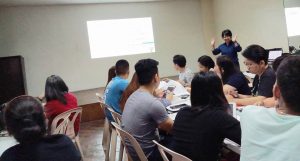 PIQC has started designing tests based on Bloom’s taxonomy, but for better mastery, another training was set on May 16.
PIQC has started designing tests based on Bloom’s taxonomy, but for better mastery, another training was set on May 16.
Ms. Katrina Grace Sumaguit, Math Teacher, gave the talk on Classifying Test Items using Bloom’s Taxonomy. Bloom’s Taxonomy is a set of three hierarchical models (cognitive, affective, and psychomotor) used to classify educational learning objectives into levels of complexity and specificity.
Ms. Sumaguit talked on the three domains of Bloom’s Taxonomy and how it will be classified on test items. She tackled the six levels of the original and revised version of the cognitive domain: Remember, Understand, Apply, Analyze, Evaluate, and Create (rather than Synthesize). She also tackled the process verbs, assessments, and questioning strategies for the teachers to construct better test items and to really assess the knowledge of students. She shared some Apple applications that support Bloom’s revised taxonomy.
The talk ended with a workshop activity. The teachers were grouped according to their subjects areas and tasked to give at least five test items that can be classified under RU (Remember and Understand), Ap (Apply), and AEC (Analyze, Evaluate, and Create). Each subject area assigned a representative to present their work which were examined and processed by Ms. Sumaguit. The talk was able to train teachers to construct tests with classified test items.
2. The Art of Critical Thinking/Incorporation of Reflection in Lesson Planning
The creation of the office of the Assistant Principal for Student Activities and Formation resulted in the redesigning of the delivery of the ESP lessons. Since the ESP is centered on values formation, a reflection as a teaching strategy becomes more effective.
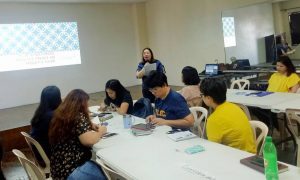 Arienne Romero Lambo of the AJHS was asked to talk on “Incorporation of Reflection in Lesson Planning” on May 17. Her talk is entitled “The Art of Questioning: Productive Struggle and Productive Failure.” She started her talk by giving reflection about the story of “The Little Boy” and “The Emperor and the Monarch Butterfly.” According to her, a good teacher should let his students struggle, for them to learn and bring out the best in them. She also gave reflections about her colleagues, students, and family.
Arienne Romero Lambo of the AJHS was asked to talk on “Incorporation of Reflection in Lesson Planning” on May 17. Her talk is entitled “The Art of Questioning: Productive Struggle and Productive Failure.” She started her talk by giving reflection about the story of “The Little Boy” and “The Emperor and the Monarch Butterfly.” According to her, a good teacher should let his students struggle, for them to learn and bring out the best in them. She also gave reflections about her colleagues, students, and family.
Mrs. Lambo talked about the importance of student engagement inside and outside the classroom. Student engagement is important because it motivates students and make them, to become life long learners. She also talked about the importance of giving high inquiry/critical thinking (divergent) and low inquiry/recall, understanding (convergent) questions, and experiencing productive struggle and productive failure to students. Low inquiry questions tend to reinforce “correct” answers, or focus on specific acceptable answers, whereas high inquiry questions stimulate a broader range of responses, and tend to stimulate high levels of thinking. On the other hand, productive struggle isn’t necessarily to get to the right answer, but to engage in this process to advance learning and develop perseverance. And lastly in productive failure, struggling during learning may increase persistence, which is important when learning complex job skills – learners likely won’t perform them correctly the first time.
Mrs. Lambo ended her talk with a workshop activity that tasks each subject area to think of a specific lesson and how they will integrate the concept of high and low inquiry questions, productive struggle, and productive failure to tackle that lesson.
3. Talk on Effective English and Filipino Communications and Language
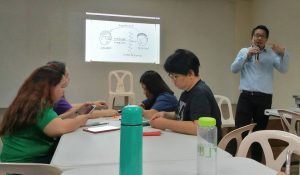 Communication is a very important aspect in the delivery of lessons and giving instructions for better understanding. The talk on Effective English and Filipino Communications and Language was facilitated by Mr. Joel Falgui, English faculty and Mr. Paolo Paculan, Filipino faculty from Ateneo de Manila Junior High School. Their talk is entitled, “Tagos sa Buto!” They started their talk with an activity that challenges the ability of the teachers to communicate well with their colleagues. The activity enlightened the teachers that communication is very important to both teacher and students.
Communication is a very important aspect in the delivery of lessons and giving instructions for better understanding. The talk on Effective English and Filipino Communications and Language was facilitated by Mr. Joel Falgui, English faculty and Mr. Paolo Paculan, Filipino faculty from Ateneo de Manila Junior High School. Their talk is entitled, “Tagos sa Buto!” They started their talk with an activity that challenges the ability of the teachers to communicate well with their colleagues. The activity enlightened the teachers that communication is very important to both teacher and students.
Mr. Falgui and Mr. Paculan tackled the concepts of sender, receiver, medium, interference, and feedback in Shannon-Weaver model of communication. The sender, or information source, is the person who makes the message, chooses the medium, and then sends the message. Usually, the teacher plays this role in a classroom discussion setting. On the other hand, the receiver is the recipient of the message from the sender. He usually gives feedback to the sender in order to make sure that the message was properly received. This role in communication model is usually played by the students. 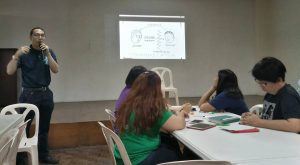 Medium is the channel used to send message. Interference is the physical disturbances like environment, people, etc. Which does not let the message get to the receiver as what is sent. And lastly, feedback is when the receiver asks for clarifications from the sender. This concept is important in classroom because it makes sure that the message given by the teacher has been well received by the students.
Medium is the channel used to send message. Interference is the physical disturbances like environment, people, etc. Which does not let the message get to the receiver as what is sent. And lastly, feedback is when the receiver asks for clarifications from the sender. This concept is important in classroom because it makes sure that the message given by the teacher has been well received by the students.
The facilitators ended their talk by tasking the teachers to answer worksheets regarding the synonyms of words commonly used by the teachers of PIQC to their test questions and translating a given question into a better question. These activities make the teachers realize that in giving clear instructions to students are very essential, especially, if the ones who are to follow these are taking important examinations, tests, etc. If these directions are too vague or hardly understandable, the students being instructed tend to do the wrong process that they result to failing that exam or test.
4. Talk on Feedbacking in Performance Evaluation
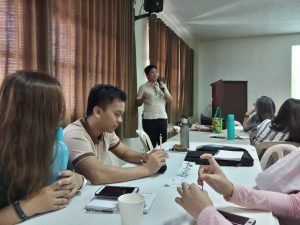 To monitor how well an institution is doing, an assessment is very important. To give a talk on feedbacking in performance evaluation, Mrs Margarita M Pavia was invited to give a talk. Mrs Pavia has served various administrative roles at the Ateneo including Assistant Principal for Academic Affairs, Math Coordinator and Head of Admissions at the Ateneo Senior High School.
To monitor how well an institution is doing, an assessment is very important. To give a talk on feedbacking in performance evaluation, Mrs Margarita M Pavia was invited to give a talk. Mrs Pavia has served various administrative roles at the Ateneo including Assistant Principal for Academic Affairs, Math Coordinator and Head of Admissions at the Ateneo Senior High School.
Mrs. Pavia started her talk by defining the term feedback. She defined feedback based on the definition of Eleanor Yearwood as the process of giving data to someone about the impact that they make through their actions, attitudes, and words. As she went through her talk, Mrs Pavia kept emphasizing the definition of feedback so that misconceptions on giving feedback may be avoided. She also tackled the importance of giving feedback and noted that giving effective feedback requires the same attention to detail that you employ when solving a technical or business problems. In giving effective feedback, the receiver must capture the situation – where or when did the behavior occur, describe the behavior – what were the specific actions , and deliver the impact to the sender – what were the consequences of the behavior. She also talked about some concepts on performance appraisal. This will be very helpful to the teachers for them to know how they are evaluated and at the same time to improve their performance and attitude.
Mrs. Pavia ended her talk with a role play that tasks the teachers to think of someone to whom they want to give feedback. This activity can help the teachers on how to give an effective feedback to someone about the impact of their actions, attitudes, and words.
Written by: Lorence D Villacrusis
